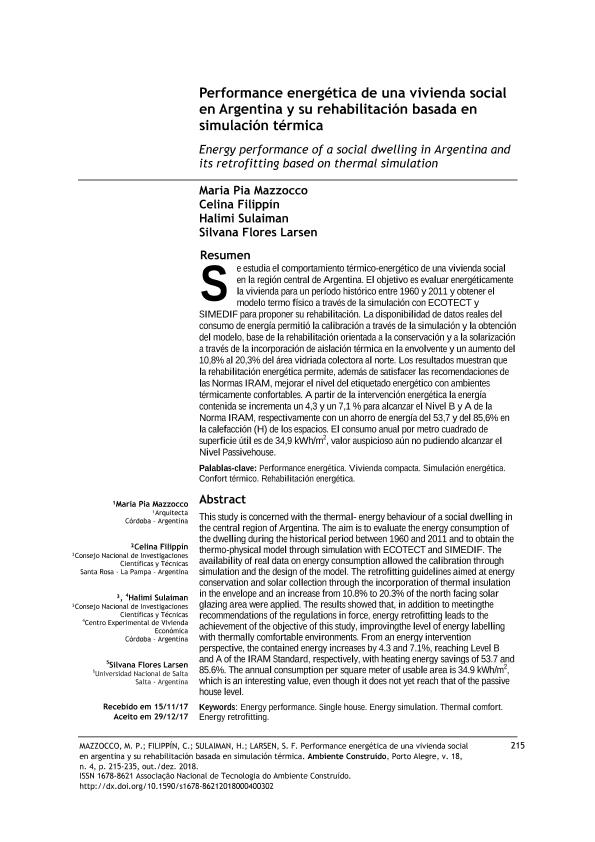Artículo
Se estudia el comportamiento térmico-energético de una vivienda social en la región central de Argentina. El objetivo es evaluar energéticamente la vivienda para un período histórico entre 1960 y 2011 y obtener el modelo termo físico a través de la simulación con ECOTECT y SIMEDIF para proponer su rehabilitación. La disponibilidad de datos reales del consumo de energía permitió la calibración a través de la simulación y la obtención del modelo, base de la rehabilitación orientada a la conservación y a la solarización a través de la incorporación de aislación térmica en la envolvente y un aumento del 10,8% al 20,3% del área vidriada colectora al norte. Los resultados muestran que la rehabilitación energética permite, además de satisfacer las recomendaciones de las Normas IRAM, mejorar el nivel del etiquetado energético con ambientes térmicamente confortables. A partir de la intervención energética la energía contenida se incrementa un 4,3 y un 7,1 % para alcanzar el Nivel B y A de la Norma IRAM, respectivamente con un ahorro de energía del 53,7 y del 85,6% en la calefacción (H) de los espacios. El consumo anual por metro cuadrado de superficie útil es de 34,9 kWh/m2, valor auspicioso aún no pudiendo alcanzar el Nivel Passivehouse. This study is concerned with the thermal- energy behaviour of a social dwelling in the central region of Argentina. The aim is to evaluate the energy consumption of the dwelling during the historical period between 1960 and 2011 and to obtain the thermo-physical model through simulation with ECOTECT and SIMEDIF. The availability of real data on energy consumption allowed the calibration through simulation and the design of the model. The retrofitting guidelines aimed at energy conservation and solar collection through the incorporation of thermal insulation in the envelope and an increase from 10.8% to 20.3% of the north facing solar glazing area were applied. The results showed that, in addition to meetingthe recommendations of the regulations in force, energy retrofitting leads to the achievement of the objective of this study, improvingthe level of energy labelling with thermally comfortable environments. From an energy intervention perspective, the contained energy increases by 4.3 and 7.1%, reaching Level B and A of the IRAM Standard, respectively, with heating energy savings of 53.7 and 85.6%. The annual consumption per square meter of usable area is 34.9 kWh/m2, which is an interesting value, even though it does not yet reach that of the passive house level.
Performance energética de una vivienda social en Argentina y su rehabilitación basada en simulación térmica
Título:
Energy performance of a social dwelling in Argentina and its retrofitting based on thermal simulation
Mazzocco, Maria Pia; Filippin, Maria Celina ; Sulaiman, Halimi Cristina
; Sulaiman, Halimi Cristina ; Flores Larsen, Silvana Elinor
; Flores Larsen, Silvana Elinor
 ; Sulaiman, Halimi Cristina
; Sulaiman, Halimi Cristina ; Flores Larsen, Silvana Elinor
; Flores Larsen, Silvana Elinor
Fecha de publicación:
10/2018
Editorial:
Associação Nacional de Tecnologia do Ambiente Construído
Revista:
Ambiente Construido
ISSN:
1415-8876
e-ISSN:
1678-8621
Idioma:
Español
Tipo de recurso:
Artículo publicado
Clasificación temática:
Resumen
Archivos asociados
Licencia
Identificadores
Colecciones
Articulos(CEVE)
Articulos de CENTRO EXPERIMENTAL DE LA VIVIENDA ECONOMICA(I)
Articulos de CENTRO EXPERIMENTAL DE LA VIVIENDA ECONOMICA(I)
Articulos(INENCO)
Articulos de INST.DE INVEST.EN ENERGIA NO CONVENCIONAL
Articulos de INST.DE INVEST.EN ENERGIA NO CONVENCIONAL
Articulos(SEDE CENTRAL)
Articulos de SEDE CENTRAL
Articulos de SEDE CENTRAL
Citación
Mazzocco, Maria Pia; Filippin, Maria Celina; Sulaiman, Halimi Cristina; Flores Larsen, Silvana Elinor; Performance energética de una vivienda social en Argentina y su rehabilitación basada en simulación térmica; Associação Nacional de Tecnologia do Ambiente Construído; Ambiente Construido; 18; 4; 10-2018; 215-235
Compartir
Altmétricas



